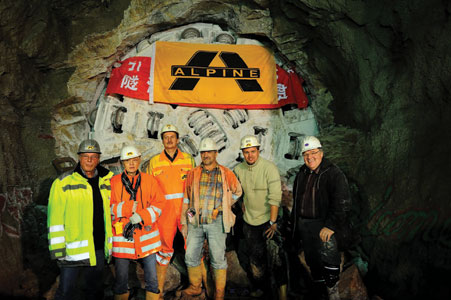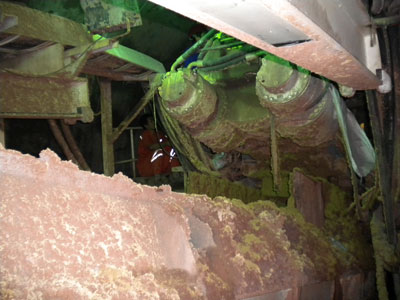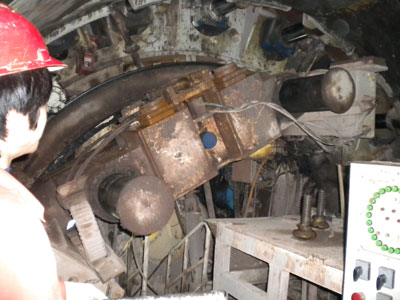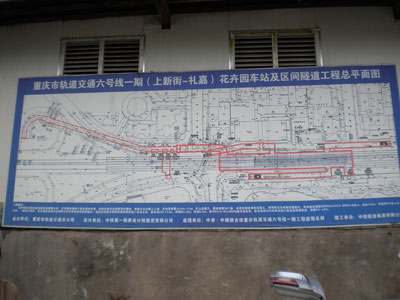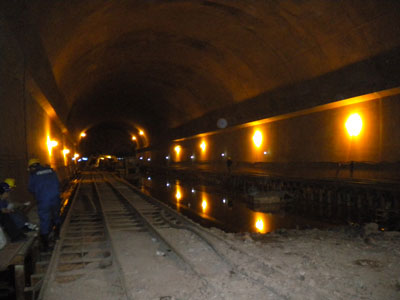Robbins consolidates presence in China
Mar 2011
Shani Wallis, TunnelTalk
-
There can be no doubt. China is the most demanding national tunnelling market in the world at present. Never has a country initiated a national public infrastructure investment program to compare with the amount of construction achieved, on-going and planned in China. Roads, railways, metro systems, hydro schemes, water, waste water and utility systems; all are on fast-track programmes of expansion and all require underground and tunnel construction on a scale that is unprecedented. A recent trip to China provided a glimpse of the demand and of how The Robbins Company is contributing to the realisation of the country's tunnelled infrastructure.
-

27 year association for Robbins in China
- China's relationship with The Robbins Company goes back a long way. It was back in 1984 that the first Robbins TBM was delivered to China for the Tianshengqiao project in Yunnan Province. The order came at a time when China was opening up cautiously to international exchange. Hard to believe now that China was for nearly 50 years closed to the outside world, but 'the sleeping giant' has well and truly woken up and its insatiable appetite for all things Western, except its form of government, is dominating the world of international trade and commerce.
- In the tunnelling industry, nearly every leading design, construction and supply company has had an association with China. Some only short lived, with issues of working in China a reach too far, while for others the association has reaped handsome rewards for both, given the various risks involved.
- For Robbins, like other international manufacturers and suppliers, early orders were filled as imports to China.
- Today, with the demand so high in China machines and goods are being manufactured in China for the domestic market and to compliment significant home-based manufacturing that continues to supply major international markets. Manufacturing in China takes advantage of lower Chinese labour costs, for the time being; fills orders directly into the largest market for the companies; and optimises production with large steel structures manufactured in China with high-end electronics, hydraulics, and sophisticated hardware, including the main bearings units, being imported for assembly at the Chinese factories.
- In China Robbins has access to impressive manufacturing capacity. From its own 1,800m2 workshop opened in Shanghai in late 2006, to joint venture agreements with modern facilities in Guangzhou, Beijing and Chengdu, the country and its demand is well covered. And the demand for Robbins machines range from its trademark hard rock TBMs to soft ground systems and in size ranges from medium 6m diameter machines for metro systems to mega machines of up to 12-13m for high-speed railway and hydro projects. The reference list of hard rock TBMs and double-shield machines supplied by Robbins to China is long and highly regarded.
- Some machines delivered as long ago as 30 years are still on active duty in China working on their forth or fifth project and into their +25km of excavation.
- In more recent times, the Robbins name has been carried on soft ground TBMs with entry into the design and manufacture of EPBMs. The company's expertise in building some of the earliest EPB machines in the world was overshadowed in the 1970s-80s by the high number of hard rock TBMs required, most notably in Norway and the Alpine regions of Europe. This expertise is being re-established to meet the tremendous increase in demand for soft-ground urban tunnelling via the Robbins association and joint venture agreement with Mitsubishi of Japan.
- In China Robbins has hard rock main beam gripper machines and several double shield machines working on important projects across the country, among them the two 10.2m diameter machines working on the West Qinling railway tunnels near Xi'an and two machines, one of 12.4m diameter, for the Jinping hydro project on the Yalong River also near Xi'an. To these there is a growing number of soft ground EPBMs engaged on metro contracts in different cities. (Tables 1 and 2).
- On a trip to China in December 2010, TunnelTalk visited two Robbins machines working on metro projects – one an EPBM working on contract for Line 2 in the city of Chengdu and the other a rock machines working on Line 2 for the Chongqing metro, a two-hour train ride away on one of China's newest high-speed railway lines - a line that has 12 km of its total 24 km length in tunnels, with 11 underground and 5 surface-level stations.
|
|
-
Chengdu EPB metro excavation
The 6.26m diameter EPBM working in Chengdu was assembled at the CSR (China South Locomotive & Rolling Stock Corporation Ltd) factory in Chengdu and delivered to site in late 2009. It is being used on Lot 18 of the city's Metro Line 2 by the 23rd Bureau of CRCC, (China Railway Construction Corporation, one of the largest construction enterprises in China). -

Delivery of segments to the Chendgu Metro site
- The machine is one of 15 TBMs working on the 17km long line and is excavating 1.4km of parallel running tunnels on the Line's southeast end. Contractors on all other sections of the line are using Herrenknecht machines.
- For the CRCC 23rd Bureau, this is its first metro tunnelling contract, having excavated many drill+blast railway tunnels for the Ministry of Railways and constructed open-cut stations for the metro system in Kunming. In Chengdu, Project Manager Li Quanshe explained that the TBM started its work on 1 January, 2010 and completed the first 1.4km drive on June 27. The second drive started on August 7 and finished on the day TunnelTalk made its site visit in mid December.
- During the work the machine and its crews recorded exceptional progress rates, producing better rates than 11 other machines on the line. Working 24h/day, 7 days/wk, and erecting 1.5m long precast segmental rings, the crews recorded bests of 18m/12 shift; 180m/wk; and 459.5m for the best month.
- The monthly rate could have been better, explained Li via the interpreter, but progress by the machine was controlled by urban restrictions on muck-away operations. On very wet rainy days, transport of muck by trucks through the city streets was not permitted and with no space on site for additional stockpiling, tunnelling had to hold up until muck disposal could resume.
-

Project Manager Li Quanshe explains the Chengdu Metro EPBM drive contract
- The geology along the alignment comprises mostly a stiff clay with pockets of gravel that comprise very hard stones of about 25cm diameter and up to 200 MPa in UCA. The TBM drives started on a steep down gradient to pass within just 3.5m cover under a small creek continuing beneath streets of houses and a market with a maximum 22m cover.
- To minimise settlement and maximise ground control, the EPB excavation system was specified for the contract. The Robbins EPBM has a 14m long x 80cm diameter centre axle screw conveyor; a foam ground conditioning system, with the air compressor installed on the trailing backup; and a single airlock with two chambers. The cutterhead has a relatively high open to closed area ratio and is dressed with soft ground picks and seven disc cutters on the gauge (see first photo - the Chengdu Metro EPBM).
- Predicted conditions along the alignment of Lot 18 are classified as between 4-5 on the register of 1 to 9 that is used to classify soil conditions in China; 1 being the softest soils and 9 the harder end of the scale.
- In a log of conditions encountered, Li showed that conditions were often in the 5-1 to 5-3 and 4-7-2 to 4-7-3 categories. Other than under the river, Li explained, the alignment was above the water table with no water ingress and very little ground water content in the stiff low-permeability clay.
- To compensate, the TBM was injecting foam conditioning and water into the chamber to create a soft muck matrix that could fill the excavation plenum and feed material successfully up the screw. Working with Jason Xiao, the Robbins Field Service Manager, who arranged the visit and acted as interpreter, it was explained that at times up to 26,000 litres of water was being injected into the excavation chamber to break clay clods into a muck and prevent clay caking to the inside structures.
- This made for a messy transfer from the screw conveyor to the belt conveyor and into the skips, and exacerbated the wet muck haulage restrictions on the surface, but surface settlement has proven little cause for concern.
- There were also few causes for interventions under compressed air. Maximum working pressure was said to be 2 bar and of the four interventions into the excavation chamber, the first, on the first drive, was under 1.5 bar pressure and the other three (a further two on the first drive and one on the second) were in free air.
- Behind the machine a mechanical erector installed rings of bolted and gasketed precast concrete segments.
- With the TBM at the end of its second drive, and Line 2 expected to start operations at the end of 2011, Project Manager Li and the Bureau 23 metro tunnelling team was looking to bid successfully for work on Line 4, Chengdu's next metro line which is programmed to start in mid-2011. As well as this Robbins EPBM ready to work on Line 4 in Chengdu, there are two other Robbins machines being used by CERC (China Engineering Railway Company) for an extension of the city's Line 2 to the west. These two machines are in the process of being assembled and are expected to begin their 3.2km long drives in June 2011.
-
Chongqing rock running tunnels
- After a 2hr journey on one of China's newest high-speed railways from Chengdu to its largest metropolis, Chongqing, the visit was to a twin set of rock TBMs working on a 6km section of running tunnels for the city's Metro Line 6. Chongqing is known as the city of hills with the topography rising and falling steeply on any route across the metropolis. To stay within gradient specifications, metro alignments see reaches of high overburden reducing to minimal cover within short distances.
-

Chonqing Metro rock TBMs ready for launch
- For the most part, the geology is medium strength but highly abrasive sandstone. Fault zones, joints and fissures in this seismically active geological region of China are frequent with many of the geological features charged with high ground water content.
- In preparing for the project, the tunnel design called for systematic installation of full set ring beams on 1m to 750mm centres; rockbolts inserted on a pattern in between the sets; and a follow-up layer of shotcrete. To comply, the Robbins TBMs are fitted with a ring beam erector located closely behind the cutterhead; two Atlas Copco drill rigs fixed either side of the main beam and ahead of the lateral gripper assemblies; and a shotcrete station on Gantry 3 of the trailing backup.
- The grippers have split pads to allow contact with the rock between the closely set steel rings; the shotcrete nozzle is on a ring beam carrier that provides 360° coverage of the tunnel walls and a 3m longitudinal travel independent of the backup; and the drill rigs are capable of drilling horizontally probe holes as well as pre-excavation grouting arrays and lateral bolt holes. Muck is transported in trains of Chinese designed and manufactured logos and muck skips to the portal site where each skip is lifted and tipped for discharge.
-

Raised invert deck
- The contractor for the Chongqing Line 6 contract is the China Railway Tunnel Group (CRTG), which is the same group that is operating two Robbins rock TBMs on the twin-tube Qinling West railway tunnel high in the Qinling Mountains about 460km from Chongqing. As a result, the two projects have several working practices in common.
- The Qinling project mobilised ahead of the Chongqing metro contract and with both projects in potentially faulted conditions with the probability of high groundwater inflows, both contracts adopted a raised deck for the service rail tracks. A steel grid deck supported at about spring-line on pre-fabricated steel frames at 1m spacings, maintaining a water drainage channel in the tunnel invert.
- On the metro project, a walk into the tunnel confirmed that water ingress was low with geological conditions remaining on the positive side. As a result the systematic steel rings at 1m or less spacings through the drives looked excessive and the application of rockbolts and shotcrete also looked as if complying with specifications rather than performing a necessary primary support and encasing function.
- With little water ingress and a relatively flat metro gradient, the space beneath the steel grid deck was filling instead with material falling off the filled muck skips as they passed. This will create a major clean-up process and at a low point on the alignment, the dip was holding water to above the deck level.
-

Tightly spaced systematic ring set
- When TunnelTalk visited, the second TBM had just completed its first drive, reaching the breakthrough wall of the fifth station box on the contract's 12km Line 6 alignment. Its twin machine had completed the parallel drive some weeks earlier. Both machines were expected to wait until after the Chinese New Year holidays in early February 2011 and until the station box is ready to receive their breakthrough. Once in they will then be walked across the station box to relaunch at the opposite end-wall for the run to the next station.
- A special frame was built and used to walk the TBMs from their initial portal assembly blocks to the working faces at the end of the drill+blast starter tunnels, and will be used again for walking the machines across the station boxes.
- Dave Fisher, a technician and site representative on Robbins TBM projects in China for some 15 years, conducted the tour of the site for TunnelTalk and explained that the TBMs were working well. "They are two High Performance machines and have ample power and thrust capacity for these rock conditions. The 6.4m diameter cutterheads are dressed with 19in cutters which are powering through the medium strength sandstone.
- Average advance rates are 25m to 30m/20h production day with a best of 47m/20h shift and 1,148m/month." There is very low damage to the disc hubs or bearings but the abrasive sandstone wears the cutter rims to razor-sharp edges. "The 19in cutters have a 38% greater ring wear volume, on average, than 17in cutters," said Fisher, "and, despite the abrasive wear of the sandstone, cutter changes have been low with only 84 face cutters and 16 centre cutters changed for both TBMs combined, on their two 6,663m drives to date."
- Fisher, who was also at the Qinling project for assembly and startup of that project's two TBMs in early 2010, explained that the two Chongqing metro TBMs are also designed with the facilities to apply the 'McNally' system of immediate support whereby long rods or rebar are installed in channels in the TBM cutterhead shield and fed out as the machine advances. These are pinned to the tunnel crown with mine straps held in place with rock dowels. "The system is effective for supporting fractured, friable or faulted conditions in the crown," said Fisher, "but it hasn't been needed on these metro drives to date. Installation of the steel sets, rockbolts and shotcrete as specified is managing support needs adequately."
-

All quite at the surface muck-train discharge station
- It was unclear if a final insitu concrete lining was to be installed to finish the running tunnels. With the second machine at the end of its drive the day before the visit, many of the site managers and workers were either already on December year-end holidays or away at meetings leaving all at the site quiet and at rest.
-
China's working environment
The Robbins TBM visits to metro projects in mega-cities of China illustrated the complexity of geological conditions in these cities and the geotechnical demands on the TBMs employed for the work. It is also difficult to understand the tunnel design and contracting arrangements in the country, as well as the level of authority on site to adapt design specifications to conditions as encountered, which appeared to be limited. - China is a complex country which is going its own way to develop a tunnelling industry to build with the tremendous amount of tunnelling that it needs in short order. For TBM manufacturers the order books will remain high for China and where there is evidence of China now building its own smaller diameter utility tunnelling shields, a leading Chinese engineer in Shanghai said that orders for large diameter machines of sophisticated design and operation will remain with the leading foreign manufacturers. Good news for Robbins from where some 60% of the order book for 2010 was from China.
-
EPB beats advance of 11 other TBMs in Chengdu - TunnelTalk, May 2010
Rock TBMs attack low cover drives in Chongqing - TunnelTalk, March 2010
New support system on West Qinling TBMs - TunnelTalk, July 2010
EPBMs to usher in metro travel in Xi'an - TunnelTalk, May 2010
Robbins EPBMs undercut downtown Zhengzhou - TunnelTalk, Oct 2010
Onsite build for giant Jinping-II TBM - TunnelTalk, Oct 2008
Record setting TBMs on Yellow River drives - TunnelTalk, Jan 2001
Marathon TBM finishes at Pinglu - TunnelTalk, Dec 2010
Robbins slurry TBM for sub-sea drive in China - TunnelTalk, Sept 2010
|
|
|
|
|
Add your comment
- Thank you for taking the time to share your thoughts and comments. You share in the wider tunnelling community, so please keep your comments smart and civil. Don't attack other readers personally, and keep your language professional.


